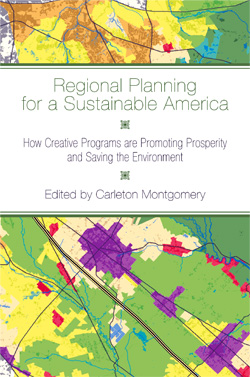The Chesapeake Bay Program is a very large regional initiative, and the most daunting to understand. Based on a compact among the federal government, three states and the District of Columbia, it is arguably not a regional planning effort at all, because it does not use any common regional vision of the pattern and design of land uses. Based on evidence that the Bay is damaged primarily by excessive nutrients flowing from residential, commercial and agricultural development in its vast watershed, the Bay Program relies on setting measurable environmental criteria which the member states commit to try to achieve through whatever land use efforts each state is prepared to institute within its own borders.
Of the states in the Chesapeake Bay watershed, only Maryland and some of its counties has adopted meaningful forms of regional land use management. However, this may change if the federal government compels the states to meet the Total Maximum Daily Loads (TMDLs) for nutrients and suspended solids which EPA has adopted for the Bay and its tributaries. In most cases, upgrades to sewage treatment plants and storm water best management practices will no be sufficient without also implementing effective growth management to preserve surviving forests and limit sprawl.
Given its size and complexity, it is not surprising that the Chesapeake Bay restoration effort calls forth a wide range of agencies, organizations, and strategies – as well as perspectives on its success or failure.
Vital Statistics:
Chapters of the Book: 17, 18 & 30
States: DC, MD, PA & VA
Year Established: 1983
Geographic Scale: 38.0 million acres
Mandatory or Voluntary over Local Government: Voluntary
Authorizing Laws: Federal & State
Agencies and Organizations:
US Environmental Protection Agency Chesapeake Bay Program Office
Interstate Commission on the Potomac River Basin (ICPRB)
Delaware’s Chesapeake Bay Watershed Implementation Plan
District of Columbia, Chesapeake Bay Program
Maryland Department of the Environment
New York Department of Environmental Conservation, Chesapeake Bay Program
Pennsylvania Department of Environmental Protection, Chesapeake Bay Program
Virginia Department of Conservation and Recreation
West Virginia, Chesapeake Bay Program
Eastern Shore Land Conservancy
Resources:
Chesapeake 2000 Multi-State Agreement
Chesapeake Bay Total Maximum Daily Load
Maryland Chesapeake Bay Restoration Plan (pdf)
Chesapeake TMDL Information, Chesapeake Bay Foundation
Selected References:
Chesapeake Bay Commission. 2003. The Cost of a Clean Bay. Chesapeake Bay Commission. www.chesbay.state.va.us/Publications/C2Kfunding.pdf.
Ernst, H. R. 2009. Fight for the Bay: Why a Dark Green Awakening is Needed to Save the Chesapeake Bay. Lanham, Maryland: Rowman & Littlefield.
Ernst, H.R. 2003. Chesapeake Bay Blues: Science, Politics, and the Struggle to Save the Bay. Lanham, Maryland: Rowman & Littlefield.
Horton, T. 2003. Turning the Tide: Saving the Bay (Revised and Expanded Edition). Washington, D.C.: Island Press.

